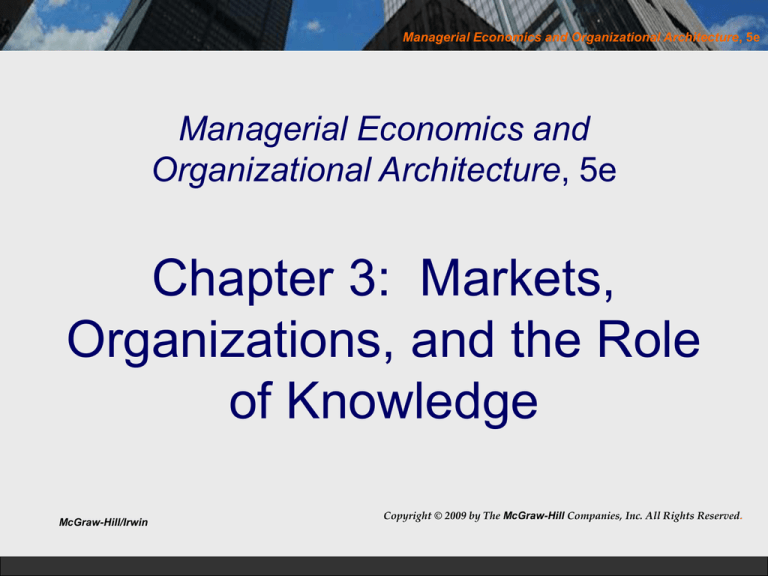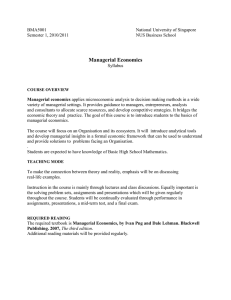
Managerial Economics and Organizational Architecture, 5e
Managerial Economics and
Organizational Architecture, 5e
Chapter 3: Markets,
Organizations, and the Role
of Knowledge
McGraw-Hill/Irwin
Copyright © 2009 by The McGraw-Hill Companies, Inc. All Rights Reserved.
Managerial Economics and Organizational Architecture, 5e
The Goals of an Economic System
• To satisfy human needs and wants
• What to produce
• How to produce it
• Who gets it
• The answer depends on the allocation
mechanisms
• Free markets
• Central planning
3-2
Managerial Economics and Organizational Architecture, 5e
Comparing Effectiveness of
Economic Systems
• Resource allocation is Pareto efficient if no
alternative helps at least one person
without harming anyone else
• In free markets, economic decisions are
decentralized to individuals
• In centrally planned economies,
government officials make economic
decisions
3-3
Managerial Economics and Organizational Architecture, 5e
Markets, Property Rights
and Exchange
• A property right is a legally enforced right
to select use of an economic good
• Private rights are assigned to a specific
entity
• private rights are alienable in that they can be
transferred to another individual, within limits
• individuals have use rights within limits
3-4
Managerial Economics and Organizational Architecture, 5e
Gains From Trade
• Individuals trade something they value
less for something they value more
• Trade creates value
• Sources of trade gains
• differences in preferences
• comparative advantage
• specialization
3-5
Managerial Economics and Organizational Architecture, 5e
Specialization
• Individuals specialize in producing goods
for which they have a comparative
advantage
• Comparative advantage occurs when an
individual has a lower opportunity cost of
producing a good
• Specialization and trade make both parties
better off
3-6
Managerial Economics and Organizational Architecture, 5e
Basics of Supply and Demand
• Demand curve—shows the quantity of a
good that consumers are willing to buy at
various prices
• Supply curve—shows the quantity of a
good sellers are willing to offer at various
prices
• Interaction of supply and demand yields a
market-clearing price
3-7
Managerial Economics and Organizational Architecture, 5e
Supply and Demand in the PC Industry
$
Supply
Surplus
Price (in dollars)
When prices are high, the
quantity supplied is greater
than quantity demanded and a
surplus exists.
When prices are low, the
quantity demanded is greater
than quantity supplied and a
shortage exists.
Only the market-clearing price
avoids surpluses or shortages.
PHI
P*
PLO
Shortage
Demand
Q
Q*
Quantity of PCs
3-8
Managerial Economics and Organizational Architecture, 5e
An Increase in Demand – shift right
P
S0
P1
P0
D1
D0
Q0
Q1
Q of PCs
3-9
Managerial Economics and Organizational Architecture, 5e
A Decrease in Demand – shift left
P
S0
P0
P1
Q1
Q0
D1
D0
Q of PCs
3-10
Managerial Economics and Organizational Architecture, 5e
An Increase in Supply – shift right
P
S0
S1
P0
P1
D0
Q0
Q1
Q of PCs
3-11
Managerial Economics and Organizational Architecture, 5e
An Decrease in Supply – shift left
S1
P
S0
P1
P0
D0
Q1
Q0
Q of PCs
3-12
Managerial Economics and Organizational Architecture, 5e
The Nature and Function of Prices
• Coordinate consumption and production
decisions
• prices give suppliers incentives to shift
production to high priced products
• prices give consumers incentives to reduce
quantity of high price products
• goods are rationed to those willing to pay
3-13
Managerial Economics and Organizational Architecture, 5e
Gains From Trade
• Consumer surplus - the difference
between what consumers are willing to
pay and what they actually pay
– measured as the area below the demand
curve and above the price
• Producer surplus - the difference between
the price received and willingness to
produce
– measured as the area above the supply curve
and below the price
3-14
Managerial Economics and Organizational Architecture, 5e
Consumer and Producer Surplus
P
$20
Consumer surplus
(Triangle A)
Supply
A
Producer surplus
(Triangle B)
$10
B
Incremental production
Costs (Triangle C)
C
Demand
10
Q
3-15
Managerial Economics and Organizational Architecture, 5e
Government Intervention
• Consumer and producer surplus can be
used to examine the effects of government
intervention on gains from trade
• Price caps limit the maximum price that
can be charged
• Price floors are a legally set minimum
price at which goods can be traded
3-16
Managerial Economics and Organizational Architecture, 5e
Government Price Cap on Gasoline
$/Gallon
Supply
Lost gains
from trade
A
$3.00
B
Excess demand
(shortage) for gasoline
$2.00 price cap
$2.00
Demand
QS
QD
Q
3-17
Managerial Economics and Organizational Architecture, 5e
Minimum Wage Laws
Unemployment
(excess supply
of labor)
Labor Supply
Minimum Wage
$5.15
A
$4.00
Lost gains from
trade
B
Labor Demand
QS
Q*
QD
Quantity of labor
3-18
Managerial Economics and Organizational Architecture, 5e
Externalities and the Coase Theorem
• Externalities occur when the actions of
one party impose a benefit or cost on
another party outside the exchange
• Pollution, noise, graffiti
• Markets may not be efficient
• Coase argued market exchange will be
efficient if:
– Property rights can be traded
– Transactions costs are sufficiently low
3-19
Managerial Economics and Organizational Architecture, 5e
Free Markets versus Central Planning
• General knowledge is freely transferable
• Specific knowledge is expensive to
transfer
• Centrally planned economies fail because
specific knowledge is not used in the planning
process
• Prices convey general knowledge
3-20
Managerial Economics and Organizational Architecture, 5e
Specific Knowledge
• Examples
• idiosyncratic knowledge of particular
circumstances
• scientific knowledge
• assembled knowledge
• Free markets make superior use of
specific knowledge dispersed among
many participants
3-21
Managerial Economics and Organizational Architecture, 5e
Why do Firms Exist?
The role of transaction costs
• Types of transaction costs
•
•
•
•
search and information costs
bargaining and decision costs
policing and enforcement costs
opportunity cost of inefficient resource
allocation
• Optimal economic organization minimizes
transaction costs
3-22
Managerial Economics and Organizational Architecture, 5e
Firms Can Reduce Transaction Costs
• Advantages of firms over markets
• fewer transactions
• information specialization
• reputational concerns
3-23
Managerial Economics and Organizational Architecture, 5e
Appendix
3-24
Managerial Economics and Organizational Architecture, 5e
Benefits of Assuming Shareholder
Wealth Maximization
• Identifies what managers should do to
meet fiduciary responsibilities
• Describes what good managers actually
do, given appropriate incentives
3-25
Managerial Economics and Organizational Architecture, 5e
Present Value of Risk-Free Investment
CFt
Present Value
t
(1 r)
Where
CFt is the cash flow in period t
r is the discount rate
3-26
Managerial Economics and Organizational Architecture, 5e
Current Value of Share of Stock
D1
D2
D
P0
...
2
(1 k ) (1 k )
(1 k )
D1
P0
kg
Where each Dt is the expected dividend at
time t, k is the risk-adjusted discount rate,
and g is a constant growth rate
3-27
Managerial Economics and Organizational Architecture, 5e
Determination of Stock Value
• Not just current dividend
but
• Expected future dividends
3-28
Managerial Economics and Organizational Architecture, 5e
Stock Market Efficiency
• Share prices respond quickly and
rationally to new information
• Prices reflect present values of expected
future net cash flows to shareholders
• Investors should not expect to “beat the
market” on a systematic basis
3-29
Managerial Economics and Organizational Architecture, 5e
Efficient Financial Markets
Management Implications
• No ambiguity about firm’s objective function
• Management decisions that do not affect current
or future cash flows are wasted effort
• New securities issued at market prices do not
threaten current shareholders
• Security returns are meaningful measures of firm
performance
3-30







